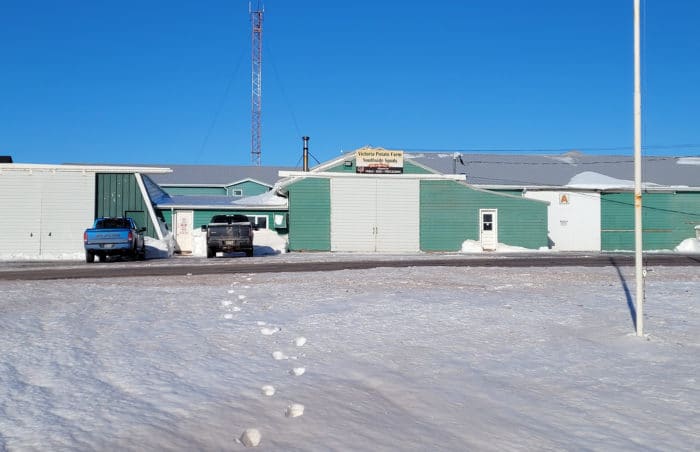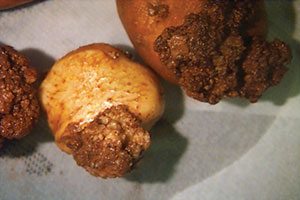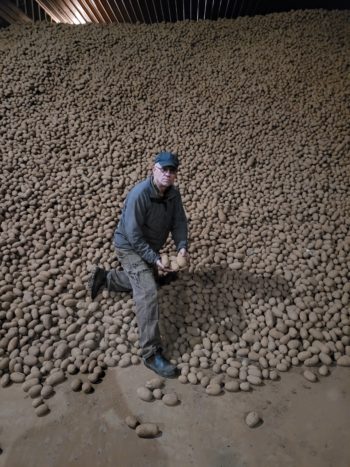P.E.I. potato growers are struggling after U.S. potato exports were halted following a potato wart discovery.
For John Visser, he knew something was wrong when he applied for a phytosanitary certificate from the Canadian Food Inspection Agency (CFIA) to export his seed potatoes to Uruguay.
It was Oct. 28, 2021, and usually it would take a few days for the CFIA to grant the certificate. After more than 40 years of shipping seed potatoes from Victoria Potato Farm in Victoria, P.E.I. to Uruguay, the process was something Visser could do in his sleep.
“At that point we knew something was off a little, but didn’t really know why. And so then, after about two and a half weeks of talking back and forth, and we were talking to people in Uruguay a lot,” Visser, who is the chairman of the Prince Edward Island Potato Board, explains in a phone interview. “(We learned) we couldn’t ship them. And the shipping window was over for us.”

Earlier in the month, Synchytrium endobioticum, the soil-borne fungus which causes potato wart, had been discovered in two fields in P.E.I. The Potato Wart Domestic Long-Term Management Plan immediately went into effect and all those in the P.E.I. potato industry thought that was it handled.
Visser’s instincts that something more was happening were right, although he couldn’t have imagined how bad it was. On Nov. 21, 2021, the Canadian government made a Ministerial Order to suspend the export of all P.E.I. potatoes to the United States. The decision stunned the P.E.I. potato industry and locked them out of the $120 million annual market.
“I couldn’t really believe that they would be doing this because there’s a management plan in place. It’s been approved by the CFIA and the USDA. And it’s a plan that has worked,” Visser says.
Visser never did receive the phytosanitary certificate for his Uruguay shipments. He later learned it was tied into the potato wart discovery.
What has followed in the months since the initial announcement has been a nightmare for P.E.I. potato growers, with many questioning if it really is about the science or if there are other forces at work.
What is Potato Wart?
Potato wart is caused by the soil-borne fungus Synchytrium endobioticum. It has been present in some continents for more than a century and was first detected in P.E.I. in 2000, since then it has been detected in 33 fields there.
It appears mainly on the stolons and tubers of potatoes, a website post from the U.S. Department of Agriculture (USDA) says. It’s hard to see symptoms above-ground. Young potato warts are white in colour and soft and pulpy in texture, and they darken and decay as they age.
Potato wart reduces yields on potatoes and can make them unmarketable. However, it poses no risk to humans or food safety.

The disease is spread by infected tubers, infected soil, machinery, implements used in infested potato fields, potato cultivation, and footwear and manure from animals that have fed on infested tubers, the USDA says. Synchytrium endobioticum is considered a U.S. federal quarantine pest and has been considered eradicated in the country since 1994.
To stop the spread of potato wart when it’s discovered in Canada, there’s the Potato Wart Domestic Long-Term Management Plan. The plan was developed by the CFIA and accepted by the USDA. It was made after the first P.E.I. potato wart discovery in 2000 and has been revised since.
According to the plan, when Synchytrium endobioticum is discovered in a field, the CFIA quarantines the field. Contract tracing is then done to determine all farm equipment used in the field and where else that equipment has been used. The seed sources for the field are also investigated.
From there other contacts are reviewed such as adjacent fields. The CFIA will do soil samples in the discovery field, with more being done in adjacent fields and other contact fields. Fields where Synchytrium endobioticum are detected in are monitored for 20 years or more after initial discovery.
“I often say they throw a big net to make sure that if it did spread, those fields are locked down and (those potatoes are) not allowed to go anywhere. Those potatoes are not allowed to leave P.E.I. and can only be used under strict standards,” Greg Donald, general manager of the P.E.I. Potato Board, explains in a phone interview.
Donald says in P.E.I. Synchytrium endobioticum has never spread through shipments. He also hasn’t seen a potato wart infected tuber in his time working in the P.E.I. potato industry over the past 30 years.
The P.E.I. Potato Wart Discovery
Potato wart was discovered in two fields in November 2020 in P.E.I. The Potato Wart Domestic Long-Term Management Plan was put in place and seed exports to the U.S. were halted while the investigation happened. The infected fields were put under monitoring and with no further detections found, and exports resumed in 2021.
The concern about the disease, however, is ongoing. In April 2021, 14 potato industry groups in the U.S. including the National Potato Council (NPC) wrote a letter to the USDA stating their concern for how Canada would handle future potato disease threats.
On Oct. 1 and 14, 2021 concerns became reality when Synchytrium endobioticum was discovered in two different P.E.I. commercial potato fields by the CFIA Charlottetown Laboratory. The fields were already under CFIA surveillance due to association with earlier investigations.
After this discovery, the Potato Wart Domestic Long-Term Management Plan was immediately put in place and seed exports to the U.S. were suspended on Nov. 2.
P.E.I. Potato Wart Timeline
On Nov. 16, the NPC and 13 state potato organizations sent a letter to USDA Secretary Tom Vilsack asking the U.S. government to suspend all imports of P.E.I. potatoes — not just seed. In a news release, the P.E.I. Potato Board said based on discussions they had, the calls for further border restrictions weren’t reflective of the whole American potato industry.
“It’s this rapid succession of detections is what’s driving this. The circumstances on the ground are clearly indicating that the situation is not under control,” Kam Quarles, NPC CEO, explains in a phone interview.
The U.S. then expressed serious concerns to the Canadian government and said it would impose a federal order banning imports of all fresh P.E.I. potatoes if Canada didn’t act first to suspend trade. So, in response, the Canadian government made a Ministerial Order suspending the export of all P.E.I. potatoes, whether fresh or seed, to the U.S. on Nov. 21.
“When this first happened, most people we talked to, we reached out processors, packers down (in the U.S.), they didn’t even know about it. And the only person that really knew about it was National Potato Council,” Donald says.
Since the suspension was announced, the government has formed an industry working group on the issue and announced $28 million in federal funding for affected growers. In a news release about the funding, the government says the money will be used to support the diversion of surplus potatoes to organizations such as food banks.
On Dec. 23, a national survey of potato wart by the CFIA was released. The expedited survey found no further detections of potato wart or Synchytrium endobioticum in Canada.
However, U.S. exports still don’t have the green light.

Before U.S. exports are resumed, the NPC wants it to be determined where Synchytrium endobioticum is in P.E.I., for the CFIA to reinstate more soil testing and for secondary measures to be put in place to minimize future risks.
“It’s entirely in the technical experts court to get that information together, and then figure out what the data is telling them,” Quarles says.
However, P.E.I. Potato Board’s Donald questions though how much of this issue is based on science or if it boils down to a trade issue. If it’s a trade dispute issue he says it needs to be dealt with as that.
“There’s absolutely no reason why table potatoes that are washed and sprout nipped shouldn’t be going to the U.S. They say it’s a technical discussion, but there’s no good technical reason why they shouldn’t be other than (the U.S.) don’t want them in there,” he says.
An Ongoing Saga for P.E.I. Potato Growers
Before exports to the U.S. were halted, the P.E.I. potato industry was having its best season in years. Following successive years of weather issues, growers in P.E.I. had experienced perfect growing conditions and produced a record crop of 28.51 million hundredweight.
“The best crop I’ve ever seen yield-wise and also quality-wise, in a market that needs it. Prices were record prices right before the border closure,” Donald explains. “There’s good demand and it was going to be a year to make up for some of those bad years when not everything lined up. And then this came out of the blue. It’s just created tremendous stress.”
The stress is all too real on Visser’s farm. Victoria Potato Farm grows seed, processing and fresh potatoes. While the processing sales-maintained status quo, fresh and seed sales have become a trickle since the border closure.

“Most of our table stock ends up going to the States through a couple of dealers and things came to a grinding halt. We’ve only done I think five or six loads to Ontario since the border has closed and it doesn’t make much of a hole in a nice pile of potatoes,” Visser says.
He doesn’t know what will happen to his seed stock come planting time as he can’t ship it to the U.S., and even sales to other provinces in Canada aren’t guaranteed. The stress is mounting for Visser, his brother Melis Visser, brother-in-law Ian Gilroy, and his sons Jordan and Cameron, who all work on the family farm.
Visser isn’t alone though in his stress, however. Many potato growers across the province are facing many of the same issues. Good quality potatoes are sitting in storages across the Island, unable to be shipped or sold anywhere.
“I’ve been in the business over 30 years, and it’s probably the worst thing I’ve had to experience, I’ll say actually, and it’s been for a whole bunch of reasons, but just the economic impact, we’re losing close to two and a half million dollars a week,” Donald says.
Donald says the federal funding support will only make a tiny dent in the income farms are losing across the Island. With production costs on the rise heading into the 2022 growing season, he expects some farms may not make it through this.
“We have a huge amount of sympathy for what’s going on there,” Quarles says. “No one takes any of this lightly. We want to see that testing resumed very quickly. The hope is that that testing will show that there are a substantial number of fields in P.E.I. that are clean and should be eligible to resume shipment.”
Once shipments do resume, however, it might be too late to restore relationships. Visser worries he may not be able to repair his Uruguay seed potato export relationship. He also isn’t sure what he’s going to plant this growing season.
“We’re not sure what we’re going to do yet, have no idea. I just don’t know what’s going to happen over the next month, two months, three months. Just a lot of uncertainty and needless uncertainty,” he adds.
Header photo — A pile of potatoes at Victoria Potato Farm in Victoria, P.E.I. The potatoes are unable to be sold due to the current export ban for P.E.I. potatoes to the United States. Photo: Victoria Potato Farm
Related Articles
Oversupply, Export Issues Weigh on Canadian Potato Market
P.E.I. Fresh Potato Exports to Puerto Rico May Resume Within Two Weeks
P.E.I. Potato Wart Discovery Sees All U.S. Potato Exports Halted








